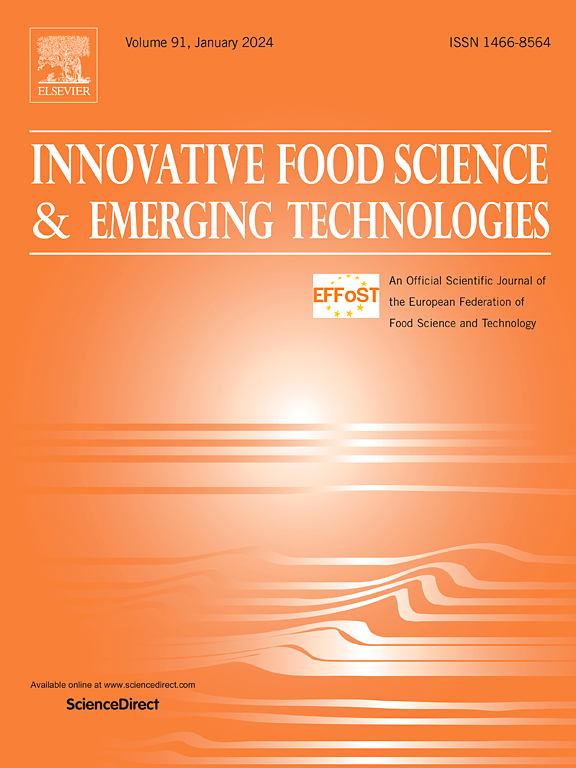射频加热与脉冲真空联合技术提高花生干燥特性和热质传递
IF 6.3
1区 农林科学
Q1 FOOD SCIENCE & TECHNOLOGY
Innovative Food Science & Emerging Technologies
Pub Date : 2025-03-07
DOI:10.1016/j.ifset.2025.103976
引用次数: 0
摘要
本研究旨在开发一种创新的射频脉冲真空干燥(RFPVD)技术,以提高花生荚的干燥效率。与热风干燥(HAD)相比,RFPVD显著提高了花生荚的升温速率,升温速率从0.31°C/min提高到1.98°C/min,同时快速补偿了干燥过程中脉动压力和水分蒸发造成的热量损失。用Midilli模型对花生荚的RFPVD过程进行拟合,拟合优度最高。在Midilli模型中,n和b的值较大,说明RFPVD对花生豆荚的水分迁移产生了较大的驱动力。这些现象取决于射频体积加热和脉冲真空协同产生的各向同性温度和湿度梯度,如传热传质模拟结果所示。与HAD相比,RFPVD由于壳的孔隙率(48.28% - 55.74%)更大,籽粒的孔隙结构更多,显著提高了干燥效率。由于RFPVD缩短了干燥时间和氧接触时间,花生蛋白和脂肪酸的保留量较高。虽然提高干燥温度和延长常压保温时间导致酸值升高,过氧化值波动较小,但均符合食用油标准。本研究探索了花生荚独特的RFPVD特性和传热传质行为,为花生荚内物料的干燥提供了一种新技术。本文章由计算机程序翻译,如有差异,请以英文原文为准。
Combined radio frequency heating and pulsed vacuum technology to enhance drying characteristics and heat-mass transfer in peanut pod drying
This study aims to develop an innovative radio frequency pulsed vacuum drying (RFPVD) technology to improve the drying efficiency of peanut pods. Compared to hot air drying (HAD), RFPVD significantly enhanced the heating rate of peanut pods from 0.31 to 1.98 °C/min, while also rapidly compensating for heat loss due to pulsating pressure and moisture evaporation throughout the drying process. The Midilli model exhibited the highest goodness of fit in modeling the RFPVD process of peanut pods. The larger values of n and b in Midilli model indicated that the RFPVD generated a substantial driving force for the moisture migration of peanut pods. These phenomena depend on the isotropic temperature and humidity gradients synergistically created by RF volumetric heating and pulsed vacuum, as visualized in the heat-mass transfer simulation results. Compared with HAD, the RFPVD significantly boosted the drying efficiency due to larger porosity (48.28 %–55.74 %) in shells and more pore structures in kernels. Due to the excellent shortening of drying time and oxygen contact time by RFPVD, peanut proteins and fatty acids were retained in higher quantities. Although the increased drying temperature and longer atmospheric pressure holding time resulted in an increasing acid value and produced lesser fluctuations in the peroxide value, both met the edible oil standard. This study explored the unique RFPVD characteristics and heat mass transfer behavior of peanut pods, which presented a novel technique for drying in-shell materials.
求助全文
通过发布文献求助,成功后即可免费获取论文全文。
去求助
来源期刊
CiteScore
12.00
自引率
6.10%
发文量
259
审稿时长
25 days
期刊介绍:
Innovative Food Science and Emerging Technologies (IFSET) aims to provide the highest quality original contributions and few, mainly upon invitation, reviews on and highly innovative developments in food science and emerging food process technologies. The significance of the results either for the science community or for industrial R&D groups must be specified. Papers submitted must be of highest scientific quality and only those advancing current scientific knowledge and understanding or with technical relevance will be considered.

 求助内容:
求助内容: 应助结果提醒方式:
应助结果提醒方式:


